Inside the Last Beatles Song: How 'Now and Then' Brought the Fab Friends Together One Final Time (Exclusive)
- Oops!Something went wrong.Please try again later.
- Oops!Something went wrong.Please try again later.
- Oops!Something went wrong.Please try again later.
- Oops!Something went wrong.Please try again later.
- Oops!Something went wrong.Please try again later.
- Oops!Something went wrong.Please try again later.
- Oops!Something went wrong.Please try again later.
The new Beatles' single, decades in the making, will finally be heard on Nov. 2
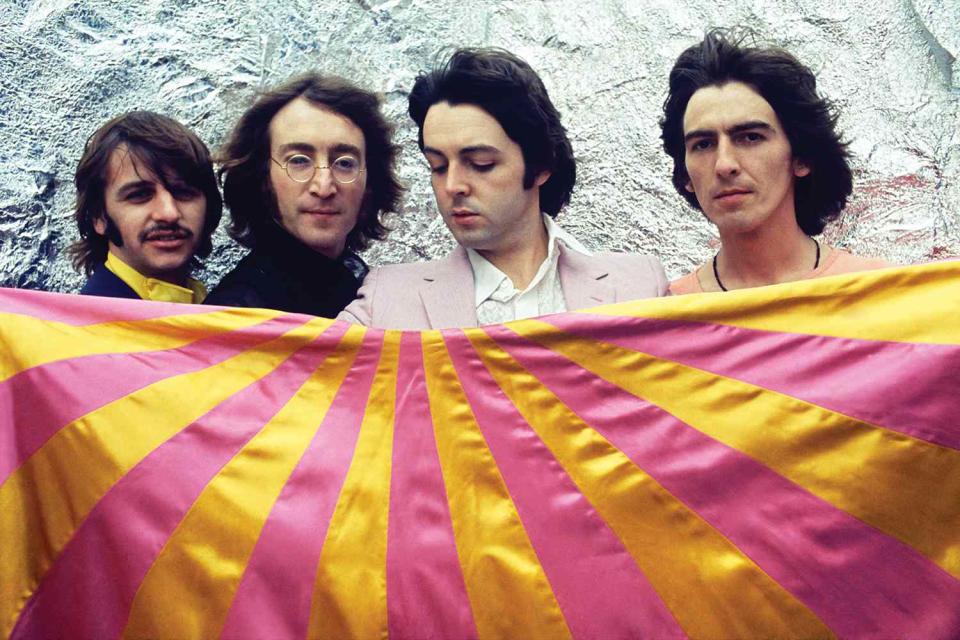
Apple Corps Ltd.
The Beatles during a photo session in London on July 28, 1968On Oct. 5, 1962, the Beatles released their first original song, “Love Me Do.” On Nov. 2, 2023, they will release their last, “Now and Then.” Before revealing details about the newly completed track featuring all four Fabs — a technological marvel nearly 45 years in the making — allow us to share an anecdote.
It’s February 1981. Paul McCartney is busy recording at George Martin’s studios on the Caribbean island of Montserrat. Work helped dull the unimaginable pain of John Lennon’s murder two months earlier, and the presence of the Beatles’ longtime producer was no doubt an added comfort. As the sessions evolved, McCartney invited rock pioneer Carl Perkins to join him. The man behind "Blue Suede Shoes” was an early hero to the Beatles, and McCartney gave him the VIP treatment during his stay. Grateful for the hospitality, Perkins channeled his feelings into a song. “I thought I might run short of words telling Paul how much I appreciated him having me down there,” he later said, “so I wrote down some words and put a little tune to them.” Called “My Old Friend,” he played it for McCartney and wife Linda as a farewell present. The tender ballad closed with these lines:
My old friend,
May this goodbye never mean the end
And if we never meet again this side of life
In a little while, over yonder,
Where it’s peace and quiet
My old friend,
Won’t you think about me every now and then
According to Perkins, McCartney grew emotional upon hearing the last verse and excused himself. Perkins apologized profusely to Linda for upsetting her husband, but she insisted that there was no need. As she tearfully explained, his lyrics eerily echoed Lennon’s goodbye during their final visit. “She said those were the last words that John Lennon said to Paul in the hallway of [John’s apartment at New York City’s] Dakota building,” Perkins told Goldmine in 1996. “[John] patted him on the shoulder and said, ‘Think about me every now and then, old friend.’”
As far as Linda was concerned, it was a necessary catharsis for her husband. “Carl, thank you so much,” Perkins recalled her saying. “He’s crying and he needed to. He hasn’t been able to really break down since that happened to John. But how did you know? There’s just two people in the world that know what John said to Paul. Me and Paul are the only two that know that…” Perkins didn’t have an answer. It seemed to border on the supernatural. "McCartney really feels that Lennon sent me that song,” Perkins would say.
McCartney himself has never commented on the genesis of “My Old Friend,” or these parting words he supposedly shared with his creative soulmate. But if the story is true, one can only imagine his reaction when, years later in 1994, Yoko Ono passed him a pair of cassettes — home demos recorded by her late husband at the end of the ‘70s, now earmarked for McCartney to see through to completion. There, scrawled across one of the tape labels in his cowriter’s familiar hand, were the words “Now and Then.” Surely he made a mental note of that one.
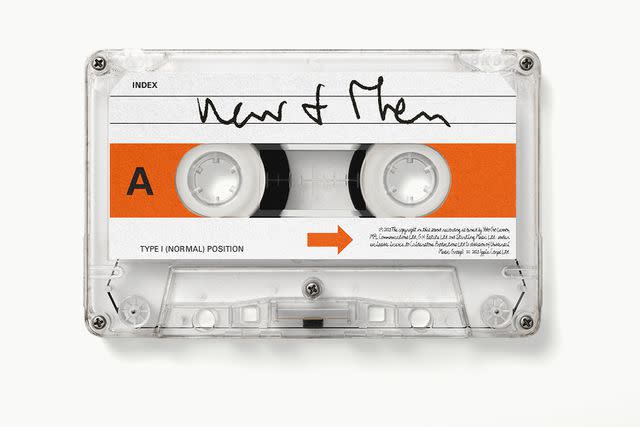
Apple Corps Ltd.
The limited-edition cassette of the new Beatles single "Now and Then," with the label in Lennon's handwriting.The exchange was part of 1995’s Beatles Anthology, the massive multi-media archival project that reunited McCartney with surviving band members George Harrison and Ringo Starr to work on three unfinished Lennon songs. Holed up at McCartney’s Hogg Hill Mill studios with Electric Light Orchestra maestro (and Harrison’s Traveling Wilburys' colleague) Jeff Lynne for a few weeks in early 1994 and 1995, the so-called “Threetles” managed to complete two tracks, “Free As a Bird” and “Real Love.” But the third, “Now and Then” was quickly abandoned . (In a press release, Harrison’s widow Olivia claims they quit after “several days.” Lynne has said they spent “one day — one afternoon, really, messing with it.” And Ringo Starr told PEOPLE earlier this year, “we worked on it for 10 minutes.”)
The problems were technical rather than musical. Lennon had recorded the piano sketch through a boombox at his Dakota apartment, and his performance was obscured by the din of his daily life: traffic on Central Park West and television chatter. Though a fascinating domestic document, it was hardly professional grade recording. With Lynne and Co. unable to eliminate the background noise — and a stubbornly persistent hum heard throughout the tape — “Now and Then” was deemed unusable (or, more accurately, “f---ing rubbish” by Harrison) and shelved.
The song languished for decades, though McCartney never forgot it. Over the years he referenced “Now and Then” repeatedly in interviews. "That one's still lingering around,” he said in a 2012 documentary on Lynne. “So I'm going to nick in with Jeff and do it. Finish it, one of these days.” But the technology lagged behind, and the death of Harrison in 2001 made the goal seem further away than ever.
A crucial breakthrough came during the production of Peter Jackson’s 2021 docuseries Get Back. Perhaps fittingly, the film that reframed the end of the Beatles would bring them together one last time. Jackson's audio team at Wingnut Films developed cutting-edge sound separation techniques, which removed stray guitar strums and other background noise that obscured much of the dialogue and music in the original film footage.
Jackson, obviously a gargantuan Beatles fan, allowed his proprietary Machine Audio Learning software (or MAL, named for beloved Beatles roadie Mal Evans) to be used extensively by the band’s organization — most notably in 2022 to "de-mix" the original four-tack master tapes for 1966’s Revolver by isolating specific instruments and voices. This sonic innovation was the perfect solution for the problems that dogged Lennon’s “Now and Then” demo. Much as it did on Get Back, the MAL audio technology washed away the sonic mud and revealed John’s performance in stark clarity for the very first time. “There it was, John’s voice, crystal clear," McCartney says in a press release. "It’s quite emotional." Starr was equally touched. “It was the closest we’ll ever come to having him back in the room, so it was very emotional for all of us. It was like John was there, you know. It’s far out.”
More than 40 years after it was begun, the song could finally be completed.
The result will be released worldwide at 10 a.m. EST on Thursday, Nov. 2 via streaming services, and the following day on physical formats — both 7-inch and 12-inch vinyl (featuring cover art by legendary artist Ed Ruscha) and a limited edition cassette. In keeping with the “Now and Then” theme, the double A-side single pairs the last Beatles song with the first, “Love Me Do.” A music video for “Now and Then,” directed by Peter Jackson, will also premiere on Friday, Nov. 3, preceded by a 12-minute documentary film featuring exclusive footage and commentary from McCartney, Starr, Harrison, Jackson, and Sean Ono Lennon set to debut on the Beatles YouTube channel at 3:30 p.m. EST on Wednesday, Nov. 1.
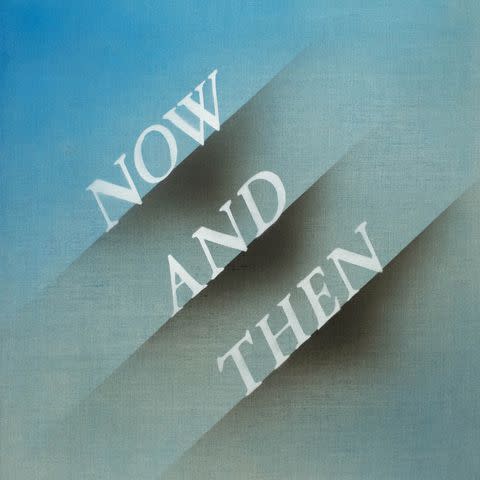
Apple Corps Ltd.
Artwork for the new Beatles single "Now and Then" by Ed Ruscha.The elaborate roll-out follows months of press speculation on what’s become one of the worst kept-secrets in rock. While McCartney first teased a new Beatles song in a BBC Radio 4 interview this summer, a major hint came a year earlier, during McCartney’s June 2022 headline set at Glastonbury. The gig featured a “virtual duet” with Lennon on “I’ve Got a Feeling,” replicating the Beatles famous 1969 rooftop performance seen in Get Back with Lennon’s isolated vocals. The striking moment, facilitated once again by Peter Jackson’s audio technology, was a dry run for a reunion on record.
For a co-producer, McCartney enlisted Giles Martin. As the son of the late Beatles producer Sir George Martin, and the de facto steward of the band’s recorded legacy, he was the obvious choice. “It was Paul’s initiative to finish the song," Martin tells PEOPLE, "as is the case with most Beatles things — even with my dad back in those days. Paul dipped in on his tour when he wanted to use John's singing [onstage]. He worked with Peter Jackson for that. And then he sent Peter the tape [of “Now and Then”], which Peter worked on. Paul also started working on the track and played me what he had. Then we talked about it and that's how I got involved.”
The song grew up and around Lennon’s original late ‘70s vocal. In 2022, McCartney re-recorded Lennon’s piano line and added bass and guitar contributions of his own, before passing the tape to Starr to overdub a new drum part. Harrison’s input takes the form of acoustic and electric guitar tracks pulled from the aborted 1995 session. To insure his influence was felt, McCartney added a Harrison-style slide solo in tribute. Finally, they tracked a majestic string section at the iconic Capitol Studios in Los Angeles, scored by McCartney, Martin and Ben Foster. The arrangement imbued the one-time demo with the grandeur of a late-era Beatles standard.
Though he’s spent the better part of a decade overseeing remasters and lavish box sets, Martin admits that contributing to a brand new Beatles song was something different entirely. “To be completely honest, I was more frightened doing this track than I had been doing remix projects, because you have to respect John and George. They aren’t with us now, but they play on the track. Your job is to help make this track as good as it can be,” he explained. “It was really interesting when we were doing the strings, I sat with Paul and he said, ‘Listen to George's rhythm. We need to respect George's rhythm guitar, because he's playing a certain thing. We need to make sure the strings pick up on that.’ Paul’s very good at making sure that there’s cohesion between everyone's ideas. He’s very good at actually going, ‘What was everyone trying to say here and let's make sure it’s all together.’”
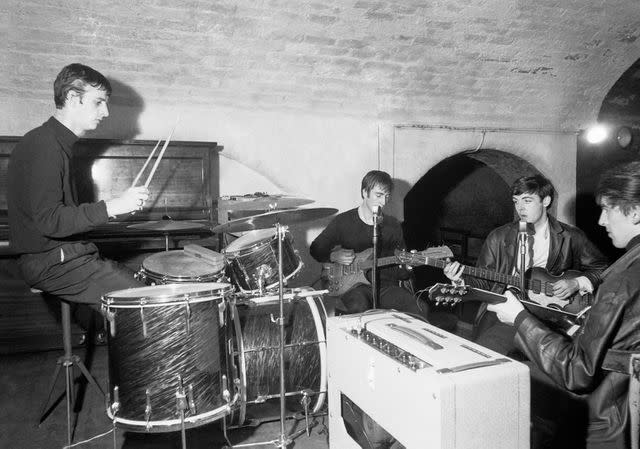
Apple Corps Ltd.
What's widely believed to be the first photo of all four Beatles together, taken during a session at Liverpool's Cavern Club on Aug. 22, 1962.The biggest challenge for Martin was making a coherent recording from tapes recorded across three separate decades, in wildly varying environments, utilizing vastly different technology. To smooth over the cracks, he drew on skills he’d perfected while assembling 2006 Beatles’ “mash-up” album Love. “I added some backing vocals from other Beatles tracks to create some coherence and to make sure that it sounds like the Beatles.” Sharp-eared listeners will detect harmonies borrowed from “Because,” “Here, There & Everywhere” and "Eleanor Rigby.” The effect is arresting, though it initially made McCartney nervous. "When I [first] talked to Paul about it, he was uncomfortable because that is reconstitution. But there was a mission. George and John are not here. I couldn’t get the classic three-part harmony — George, Paul and John singing together. There’s a sound to it. So you go, ‘Well, they would probably be putting oohs and ahhs here…Let’s just find ones in the same key and use those.’” (The parts are also thickened with new backing vocals recorded by McCartney and Starr in 2022.)
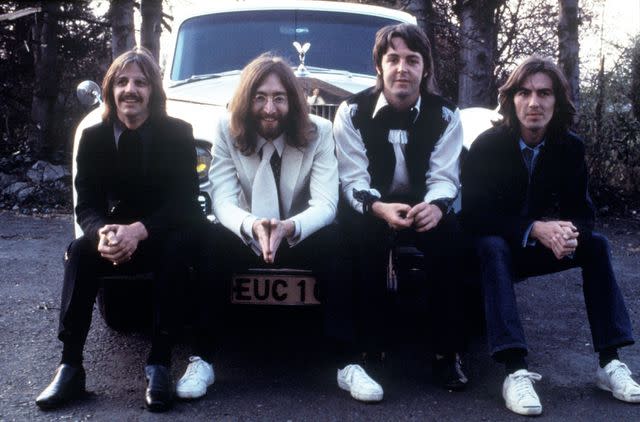
Apple Corps Ltd.
The Beatles during one of their final photo sessions on April 9, 1969, in the London district of in Twickenham.Aside from this repurposing, all other sounds were recorded specifically for the song — and by humans, no less. Martin was quick to echo McCartney and Starr’s correction of early press reports implying that “Now and Then” was completed with synthetic tracks created by artificial intelligence. “There's no AI here. There’s a vocal extraction. Everything else is completely played live.” He doesn't even employ the standard studio practice of adjusting Starr’s drumming to a computerized time keeper. “We kept it the way they would have played,” Martin explains. “Here's the thing about the Beatles — they had a heartbeat to them. There were four hearts that would beat as one in different rhythms, and it's really important to retain that. There's a fragility to this record, which needs to be there. The fragility is the human part. If you try and iron out everything, you end up with a very bland experience. The key to this production was not to add anything that takes away from the humanity of it.”
“Now and Then” will cap off a newly remixed and expanded 50th anniversary version of the Beatles twin greatest hits set, 1962-1966 and 1967-1970, due out Nov. 10. (Better known as The Red Album and The Blue Album, respectively.) The two covers famously mirror one another, as the band lean over the banister at their London record company headquarters and beam at the cameraman, six years (and several lifetimes) apart. The first photo was taken for their 1963 debut LP; the second intended for what would become Let It Be, the last album they released as an active band. It’s a visual representation of “now and then,” captured a decade before Lennon ever wrote the song that now closes the collection.
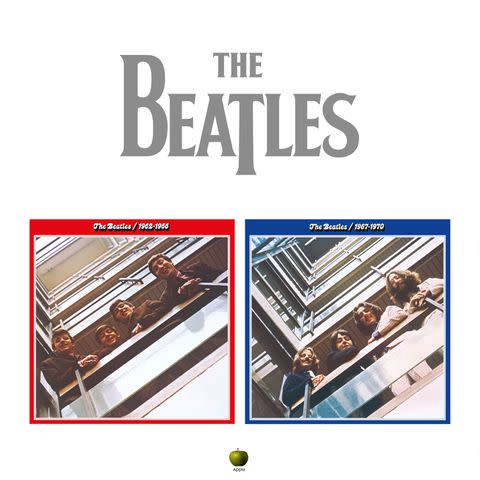
Apple Corps Ltd.
The twin covers for the Beatles' 1973 greatest hits compilation, commonly known as "The Red Album" and "The Blue Album."The Beatles were always skilled at endings, though often it was accidental. While not intended as such, the final album they recorded, 1969’s Abbey Road, concludes with “The End” — a largely instrumental track that features solos from each member before fading out with a maxim on love. It’s the perfect musical curtain call. And every Aug. 22, Beatle Twitter reminds us that the very first and very last photos of the Fab Four together were taken on that very day, seven years apart, in 1962 and 1969.
These are things that couldn’t have been planned. And the streak continues in 2023. Through a series of extremely unlikely circumstances, “Now and Then,” a literal and figurative melding of the past and present, is The Last Beatles Song. It marks the end of a journey that many fans started as children; glued to a black-and-white TV set nearly 60 years ago, fixated on a parent’s car radio, passing time singing on a school bus, or any one of a thousand ways that Beatles music first enters one’s life. We’re older now. So are they. A look back on people and things that went before, some dead and some living, feels like an appropriate sign off.
Many have theorized that Lennon was eying some form of reunion with McCartney prior to his murder on Dec. 8, 1980. No one will ever know for sure, but the thought certainly lends a level of significance to the words of "Now and Then."
And now and then
If we must start again
We will know for sure
That I love you
Martin is unable to confirm the song’s lyrical significance to McCartney, but he has his suspicions. “I do feel as though ‘Now and Then’ is a love letter to Paul written by John. I mean, I've never really asked Paul about it, and I'm not sure whether Paul would say, ‘Oh, that's definitely it,' because he wouldn't want to second guess John. But that's the sense I get. And I get the feeling that's why Paul was so determined to finish it.”
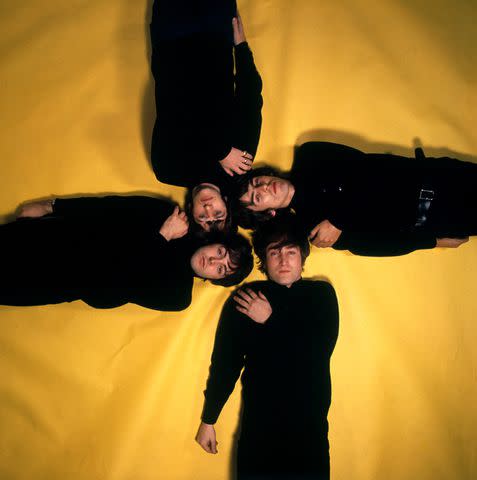
Apple Corps Ltd.
The Beatles at a 1965 photo session.And in the end, what did the Beatles mean? “Friendship” is as good an answer as any. “Even in Get Back, which is meant to depict the acrimonious Beatles, you can see the love they have for each other, and the need they have for each other,” Martin continues. “The split needed to happen for various reasons, but you get a sense of how painful it had to be. I don't think either one ever looked for another John Lennon or a Paul McCartney. They knew there wasn't one. And so this does seem like a love letter to Paul to me.”
“It feels like this is the Beatles last song. It sounds like how the Beatles would do it now, had they all been alive. I think that makes it more real. I hope it touches people.”
For more People news, make sure to sign up for our newsletter!
Read the original article on People.

